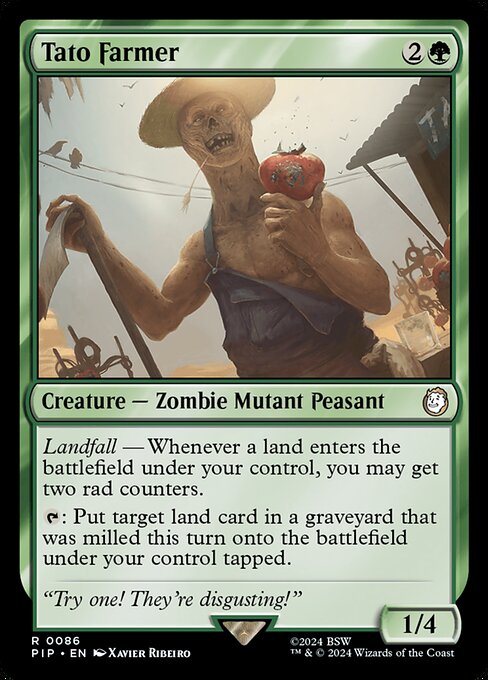
Image courtesy of Scryfall.com
Tempo with a Green Twist: Tato Farmer as a Control Engine
Green often gets cast as the color of big stompy creatures and ramp, but a closer look at Tato Farmer reveals a cunning tempo weapon built for the long game 🧙♂️🔥. With a mana cost of {2}{G} and a sturdy 1/4 body, this Zombie Mutant Peasant can weather early pressure while quietly stacking advantages that tilt the late game in your favor. The real trick, though, is Landfall: whenever a land you control enters the battlefield, you may get two rad counters. Those counters aren’t just flavor; they’re a ticking clock that nudges you toward the next sequence of plays. Each land drop becomes more than mana—it becomes momentum. And momentum, in the hands of a patient player, is a form of control.
The second ability is where the tempo engine really hums: Tap to put a target land card in a graveyard that was milled this turn onto the battlefield under your control tapped. That line reads like a riddle wrapped in a strategy guide. If you’ve milled a land that turn, you can reanimate it, entering tapped under your control and triggering Landfall again. It’s a loop that rewards precise sequencing: mill lands when you can then reanimate them to generate fresh board presence and fresh Landfall triggers. In practice, that means your opponent buys a bit of time only to watch your board tempo accelerate as you convert milling into real, immediate value. The flavor text—“Try one! They’re disgusting!”—lands as a wink to the card’s unexpected efficiency and the cheeky satire of Fallout’s wasteland vibes 🎲.
Think of the pace you want to set. In a typical game, you’ll establish a sturdy ground level with Tato Farmer on turn 3 or 4, threatening a 1/4 body that both blocks and applications pressure. Landfall converts every land drop into a new resource, and the milled-then-reanimated land sequence gives you a way to rebound from temporary setbacks—landfalls stack, and so do your options. The result is a deck that punches above its weight, trading in the old “ramp and slam” arc for a nimble, resourceful cadence that punishes players who lean too heavily on instant answers and ignores your ongoing land drops 🔥.
“Landfall isn’t just a mechanic here; it’s a tempo toolkit. Each land drop becomes a micro-win, and the ability to recapture milled lands keeps your engine alive even when opponents try to disrupt you.”
Playing the Long Game: Concepts to Leverage
Key to maximizing Tato Farmer’s tempo is thinking in terms of lines rather than single turns. Start by securing early board presence with a couple of efficient green threats or utility lands that help you stabilize. Then push a Landfall cadence: every time a land enters under your control, you’re rewarded with potential net gains—additional land drops, card filtering, or the strategic option to reanimate milled lands. The milled-to-reanimated line rewards you for milling shenanigans, so pair milling spells or effects with your own reanimation trigger to keep pushing pressure without over-committing to one fragile plan.
Defensive play is essential in tempo control, and Tato Farmer gives you a way to blend defense with offense. The 1/4 body isn’t just a speed bump; it becomes a platform for your late-game plays, especially when you can flash in a land that net-wins a Landfall trigger or turn a milling sequence into a sudden, surprising board state. Since the card is green, you have access to a broad set of removal, bounce, and protection options to keep the board manageable while you assemble your Landfall engine. This isn’t about slam-bamy inevitability; it’s about carving tiny edges on every turn until your opponents are forced to race you on a track you’ve laid out—and you’re already 2 steps ahead 🧙♂️⚔️.
Deckbuilding Notes: How to Optimize the Loop
- Prioritize lands that enable reliable land drops or provide value when they enter, so each Landfall trigger compounds your advantage.
- Include milling synergy that guarantees at least some lands end up milled this turn, setting up the graveyard-to-battlefield recursions without slowing your overall curve.
- Protect your engine with efficient interaction—removal, bounce, and a few counterspells to weather opposing disrupt effects while you tuck away incremental gains.
- Balance early pressure with late-game inevitability. The crew of green threats should cover both offense and defense, letting your Landfall triggers keep your momentum up the entire game.
- Carefully sequence your plays to maximize Landfall triggers. If you can land a series of enablers and milled lands on consecutive turns, your rad counters and board presence can grow in a hurry.
And yes, the lore matters. In Fallout’s sandbox, the world is grimy and pragmatic—much like a tempo-control plan that refuses to overcommit until it’s certain the window is open. The card’s flavor text and its art vibe reinforce the idea that even in a wasteland, small, clever moves—paired with a stubborn body—can tilt the game. It’s a reminder that MTG isn’t always about big spells and flashy finishes; sometimes it’s about making the right land drop, at the right moment, with the right recast option waiting in the wings 💎🎨.
Neon Gaming Mouse Pad 9x7 Neoprene Stitched Edges 1More from our network
- https://blog.digital-vault.xyz/blog/post/hot-blue-giant-illuminates-stellar-evolution-at-24-kpc/
- https://blog.digital-vault.xyz/blog/post/royal-booster-comparing-alternate-frame-art-versions/
- https://blog.digital-vault.xyz/blog/post/texture-driven-visuals-crafting-narrative-through-detail/
- https://transparent-paper.shop/blog/post/multi-epoch-measurements-spotlight-a-distant-hot-giant-in-sagittarius/
- https://blog.digital-vault.xyz/blog/post/the-art-of-frankie-peanuts-elevates-mtg-flavor/